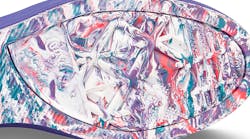It started with a mistake.
Last year, a development director at Converse messed up a batch of what was supposed to have been an experimental blue sole for a pair of Chuck Taylor All-Stars. Instead, the machine spit out a weird gunk of half-mixed rubber, swirled with an odd, sort of marbled color. It kind of looked like a bowling ball.
Before throwing it out and starting over, he texted a picture of it to Bryan Cioffi, creative director of innovation at Converse, with a note saying, "This is a mistake; we have to clean the machine."
But Cioffi saw something else.
"This was unlike anything we had ever made before," he recalled during his keynote presentation at NineSigma's Open Innovation Leadership Summit earlier this year. "I told him, 'You didn't mess up anything. Put that on the product and send it back to us immediately.'"
When it arrived, he said, his team knew it had something special -- something that went against 100 years of tradition at Converse, something that changed everything they knew about rubber, color and basic shoemaking.
To do something with that, though, they knew they had to change their system. They had to push development outside the normal R&D channels with its endless fiddling of creative iterations, the pursuit of corporate sponsorship, manufacturing partner buy-in and the tortuously long 18-month scale-up process.
To get a new product to market with this technology, Cioffi had to test the limits of Nike (IW500/44) (NKE) and Converse's innovative culture and go open innovation with the project on a massive scale.
"I said, let's break down everything we ever thought we could do before," he recalled. "Let's give the formula out to our partners immediately. Let's give everything away and get this out."
That meant, of course, bypassing IP concerns with the Chinese manufacturing partners. It also meant skipping Nike's corporate standards and protocol, overstepping the bounds of the creative department by several bounds and facing the possibility of amajor public failure.
But it didn't fail.
Open Innovation Works
Within days of Cioffi's open innovation decision, a manufacturing partner in Asia sent him a video showing, oddly, how they could use a process for making candy canes with the marbled technique. That opened up a whole new range of possibilities.
Within a month, other innovators at Nike had found ways to use that process on the outsole and even the upper shoe itself.
Within three months, Cioffi had half a dozen products ready for development with partners already trained and ready to scale.
But he didn't want to just enter them into the normal channels.
Instead, he again bypassed the corporate sponsorship protocol and set up a "science fair" in the corner of the building to show off some of the new designs.
"We decided we weren't going to keep this safe, we weren't going to keep this with our names attached to it," he explained. "We said, let's give everything away and get this out. Whoever wants it can use it."
One of the products on display caught the eye of the Vice President of Direct to Consumer Sales.
"She saw one shoe and said, 'I've never seen anything like this. I need that in my stores,'" Cioffi recalled. Specifically, he said, she wanted them there by Black Friday -- November 29, 2013.
That conversation happened in the first week of October. Which meant Cioffi and his team had to collapse the standard 18-month development time to under 50 days.
"Our developer let out a small shriek," Cioffi joked. "But I said, wait a second. If we made this happen by just kind of letting the idea do its thing, why couldn't we get it to market the same way? Let's get everyone involved."
Converse released its marbled rubber "concept" models to exclusive retail shops in Dec. 2013 before the technique made its way to the mainstream market with the Platform Plus:
In the end, that open innovation platform worked again. The Asia partners were game, distributors were game, corporate was game, and creative, well, they owned the game.
"Everybody wanted to see it happen," he said. "And it actually did happen." But not just once. And not in 50 days either.
"We didn't do it one time, we did it eight times -- we took eight brand new designs from inception to design to consumers' hands in just 22 days," he said. "It is far and away the fastest turnaround in footwear history."
The point here, he said, is not about the shoe, or even the rubber. It's not that they were able to decrease time to market or invent some cool new designs.
The point, he explained, is that -- with a great deal of ingenuity and guts -- Cioffi and his team were able to change the way the company does everything practically overnight.
"The pipes are not aligned in most companies to get an amazing idea very quickly into their customers' hands," he explained. "But we were able to change the way we thought about rubber creation with one single idea."
"We looked at our lean manufacturing process, our communication process, the way teams work," he said. "We rewrote everything we know about how to go about getting a product to market."




